
The Chocó Rainforest occupies the extreme western edge of Columbia and the eastern end of Panama, wedged in the narrow region between the Andes Mountains and the Pacific Ocean. Rain falls eight months out of the year here: it is extremely wet and humid, the perfect environment for amphibians. The most toxic frog anywhere in the world calls this mountainous jungle paradise home. Phyllobates terribilis, commonly known as the golden frog, golden poison frog, golden poison arrow frog, or golden dart frog, is notorious for secreting the highly lethal neurotoxin Batrachotoxin. This is the stuff that indigenous people of the area use to coat poison darts with, which kills quickly by causing the victim’s heart to stop beating. Scientists don’t know why the neurotoxin doesn’t kill the frogs, but they’re trying to find out.
P. terribilis (and other related poison dart frog species) do not make Batrachotoxin, but eat insects which do. Scientists think it might be a species of beetle but it hasn’t been proven. These frogs are not born with the toxin, but acquire toxicity by eating the toxin-producing insects. Frogs born in captivity never become toxic, which is why they can be purchased and kept as pets. Careless handling of a wild golden poison frog, however, means death. As a result, wild frogs have no predators (none that live very long anyway) with one exception: Leimadophis epinephelus, a small snake that has developed a tolerance of the toxin, but not immunity. As a result, L. epinephelus only preys on juveniles, not adults.
Tadpoles are grey when hatched but slowly darken until, as juveniles, they’re primarily black. Once they mature, they morph into one of several colors: bright golden yellow, golden orange, or mint green. The actual color and intensity varies. For example, it may be hard to tell if an individual is yellow or orange, and a green specimen may appear metallic green, pale green, or even white.
P. terribilis is listed as an endangered species by the International Union for Conservation of Nature (IUCN) due to habitat loss, possibly via deforestation, agriculture, habitat fragmentation, pesticides, fertilizers, toxins and pollutants. Another possible reason for their decline is over-harvesting for the pet trade market.
“This South American Frog is Deadly to the Touch” (2:36):
Scientific Classification
Kingdom: Animalia
Phylum: Chordata
Class: Amphibia
Order: Anura
Family: Dendrobatidae
Genus: Phyllobates
Species: P. terribilis
Binomial name: Phyllobates terribilis
Question Of The Night: Is the frog in the video wild, or a domesticated non-toxic pet employed for the safety of the camera crew?
